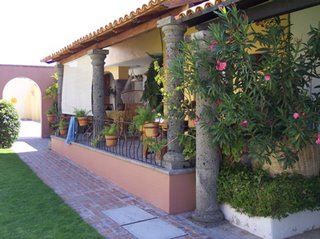 This is a photo of the front of our Mexican home.
This is a photo of the front of our Mexican home.I collapsed last night after one of the most grueling days of my fieldwork. As has been our habit of late, we all set out early yesterday in search of several things: a summer camp for the kids, the public library (the alleged "center" of the expatriate community in SMA), and a decent fruteria and carnicería. I'm having a difficult time getting my head around this town. At first glance, it seems like a typical Mexican town, but then there are aspects of being here that make it very different from the other places in Guanajuato that I've worked in and visited.
First of all, as far as I can tell, there is no mercado, or large market where individuals sel meats, cheeses, fruits, prepared foods and other miscellaneouss items. This is very strange for me, as I've never found any Mexican town or neighborhood to be as inconvenient as San Miguel appears to be. First off, there are very few banks around town. In fact, I've only found two so far. In so many towns in western Mexico is it typical to find a bank on every corner in the center of town (i.e., lots of places to change money). It's also atypical not to have a big market, and not to have little tienditas in the neighborhood. Ken and I have walked nearly a half mile in every direction of our house looking, and we haven't found any "mom and pop" tienditas within a block or two of our house. We do have supermercado in the plaza next to our home. This is great, but the produce and meat leave much to be desired.
Like many other communities in this part of Mexico, our house is located in a lovely community that is surrounded by inconsistent development. This, for example, is a photo of the neighborhood right outside our own:
 This appears to be another community under construction. But, it may be a project that's been abandoned (there hasn't been any activity there since we arrived). From my bedroom window, I can see my closest neighbors are living in small shanties. There is no consistent zoning here, but that doesn't seem to be a problem for property values, or people wanting to buy or rent here.
This appears to be another community under construction. But, it may be a project that's been abandoned (there hasn't been any activity there since we arrived). From my bedroom window, I can see my closest neighbors are living in small shanties. There is no consistent zoning here, but that doesn't seem to be a problem for property values, or people wanting to buy or rent here.The other major surprise is that many of the Americans who live here seem to be pretty young. I've set up an interview for later today with a couple who are in their early 50s. I have an appointment for early next week to interview another couple who have lived here for 5 years. They're in their mid-30s. I've seen a few older people,peoplee confined to wheelchairs, that appear to be in their 70s or perhaps older, but for the most part, the non-Mexicans I've bumped into here are younger than I would have expected for a "retiree." One thing of note, the younger couple I mentioned above bristle at the idea of being "retired." They prefer to say that they're "unemployed."
While there are plenty of McMansions and other extremely fine homes, there are a fair number of expatriates living in what I would delicately term "modest" housing, such as camper trailers and very small houses in need of lots of repair.
Last night, Ken struck up a conversation with our next-door neighbors: two Canadian sisters who are vacationing here with their children. They mentioned that their children were taking tennis lessons nearby, and that we might want to come with them to meet the tennis instructor and see about lessons for our kids (my daughter loves tennis). I really didn't want to go along, and would have preferredd to let Ken walk the kids up to meet the tennis pro. Ken was insistent that I go along, however, because as he said, "You never know what you're going to find here."
Boy, was he right. The tennis pro, it turns out, is the son of an American who came to SMA right after WW II and married a young Mexican woman. They settled permanently in San Miguel, had children and never left. His son now gives tennis lessons to Americans and others for extremely reasonable rates (my kids will have a lesson together for $12 USD per hour). He also has several apartments on his property in addition to his three pristine clay tennis courts. He raises fighting cocks, stores vehicless for people who need a place to garage their cars in San Miguel, and has plans to open an RV park on his property in the near future. This man I'll refer to as "David" is in many respects part of the puzzle of San Miguel: he is truly Mexican, but very connected to the American community here. He speaks English and Spanish, and has many American and Mexican friends. The tennis pro, in other words, was not the country club guy that I expected. He was a more typical Mexican man who, like many of his fellows throughout the republic, is making a living using the tools he has available to him.
"David" is emblematic of what I will refer to as the puzzle of SMA, the unique cultural hybrid that is not easily defined.
No comments:
Post a Comment